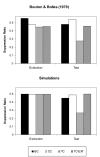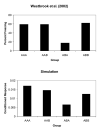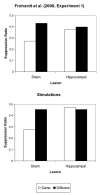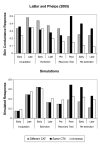Reinstatement of conditioned fear and the hippocampus: an attentional-associative model
- PMID: 17178163
- PMCID: PMC1805464
- DOI: 10.1016/j.bbr.2006.11.026
Reinstatement of conditioned fear and the hippocampus: an attentional-associative model
Abstract
An existing attentional-associative model of classical conditioning [Schmajuk N, Lam Y, Gray JA. Latent inhibition: a neural network approach. J Exp Psychol: Anim Behav Process 1996;22:321-49] is applied to the description of reinstatement in animals and humans. According to the model, inhibitory associations between the context (CX) and unconditioned stimulus (US) are formed during extinction, which help preserve the association between the conditioned stimulus (CS) and the US. However, summation and retardation tests fail to reveal these associations because (a) the CX is not attended or (b) a CX-CS configural stimulus formed during extinction is both poorly attended and weakly active during testing. When US presentations and testing occur in the same context, reinstatement is the consequence of a decreased CX inhibition and the increased attention to the CS, which activates the remaining CS-US association. When US presentations occur in the context of extinction but the CS is tested in a different context, reinstatement results from an increased attention to the CS and the combination of CS-CX and CX-US excitatory associations. The assumption that associations between CSs are impaired following neurotoxic hippocampal lesions or in amnesia, is sufficient to describe absence of reinstatement in those cases. However, additional assumptions might be needed to describe the effect of hippocampal lesions on other postextinction manipulations.
Figures





Similar articles
-
The effects of neurotoxic hippocampal lesions on two effects of context after fear extinction.Behav Neurosci. 2000 Apr;114(2):227-40. doi: 10.1037//0735-7044.114.2.227. Behav Neurosci. 2000. PMID: 10832785
-
Learning pain-related fear: neural mechanisms mediating rapid differential conditioning, extinction and reinstatement processes in human visceral pain.Neurobiol Learn Mem. 2014 Dec;116:36-45. doi: 10.1016/j.nlm.2014.08.003. Epub 2014 Aug 13. Neurobiol Learn Mem. 2014. PMID: 25128878
-
Neurotoxic hippocampal lesions fail to impair reinstatement of an appetitively conditioned response.Behav Neurosci. 1998 Feb;112(1):255-60. Behav Neurosci. 1998. PMID: 9517833
-
Timing of omitted events: an analysis of temporal control of inhibitory behavior.Behav Processes. 2007 Feb 22;74(2):274-85. doi: 10.1016/j.beproc.2006.11.003. Epub 2006 Nov 16. Behav Processes. 2007. PMID: 17194549 Free PMC article. Review.
-
Perplexing effects of hippocampal lesions on latent inhibition: a neural network solution.Behav Neurosci. 1998 Apr;112(2):316-51. doi: 10.1037//0735-7044.112.2.316. Behav Neurosci. 1998. PMID: 9588481 Review.
Cited by
-
Post-extinction conditional stimulus valence predicts reinstatement fear: relevance for long-term outcomes of exposure therapy.Cogn Emot. 2015;29(4):654-67. doi: 10.1080/02699931.2014.930421. Epub 2014 Jun 24. Cogn Emot. 2015. PMID: 24957680 Free PMC article.
-
Delayed extinction attenuates conditioned fear renewal and spontaneous recovery in humans.Behav Neurosci. 2009 Aug;123(4):834-43. doi: 10.1037/a0016511. Behav Neurosci. 2009. PMID: 19634943 Free PMC article. Clinical Trial.
-
A review on human reinstatement studies: an overview and methodological challenges.Learn Mem. 2014 Aug 15;21(9):424-40. doi: 10.1101/lm.036053.114. Print 2014 Sep. Learn Mem. 2014. PMID: 25128533 Free PMC article. Review.
-
Updating fearful memories with extinction training during reconsolidation: a human study using auditory aversive stimuli.PLoS One. 2012;7(6):e38849. doi: 10.1371/journal.pone.0038849. Epub 2012 Jun 29. PLoS One. 2012. PMID: 22768048 Free PMC article.
-
Why trace and delay conditioning are sometimes (but not always) hippocampal dependent: a computational model.Brain Res. 2013 Feb 1;1493:48-67. doi: 10.1016/j.brainres.2012.11.020. Epub 2012 Nov 23. Brain Res. 2013. PMID: 23178699 Free PMC article.
References
-
- Bottjer SW. Conditioned Approach and Withdrawal Behavior in Pigeons: Effects of a Novel Extraneous Stimulus during Acquisition and Extinction. Learning and Motivation. 1982;13:44–67.
-
- Bouton ME. Slow reacquisition following the extinction of conditioned suppression. Learning and Motivation. 1986;17:1–15.
-
- Bouton ME. Context and ambiguity in the extinction of emotional learning: Implications for exposure therapy. Behaviour Research and Therapy. 1988;26:137–149. - PubMed
-
- Bouton ME. Context, time, and memory retrieval in the interference paradigms of Pavlovian learning. Psychological Bulletin. 1993;114:80–99. - PubMed
-
- Bouton ME. Context, ambiguity, and classical conditioning. Current Directions in Psychological Science. 1994;3:49–53.
Publication types
MeSH terms
Grants and funding
LinkOut - more resources
Full Text Sources

